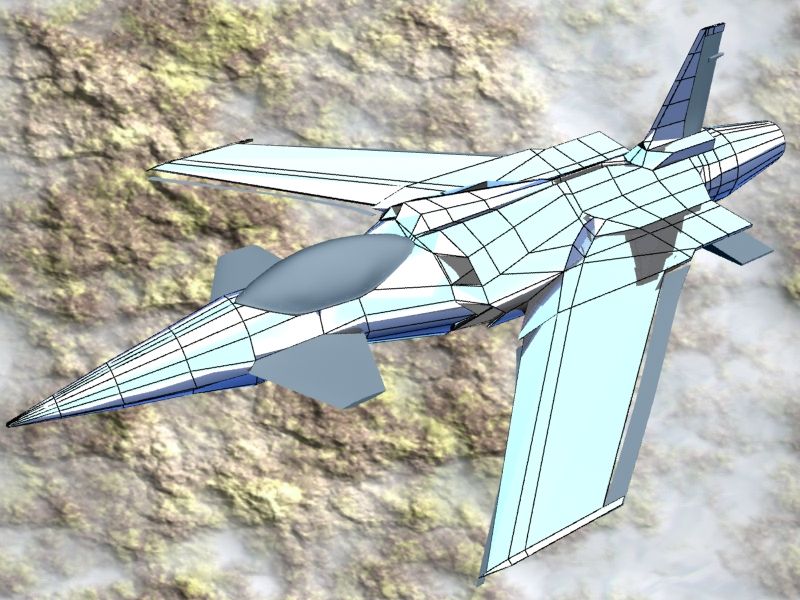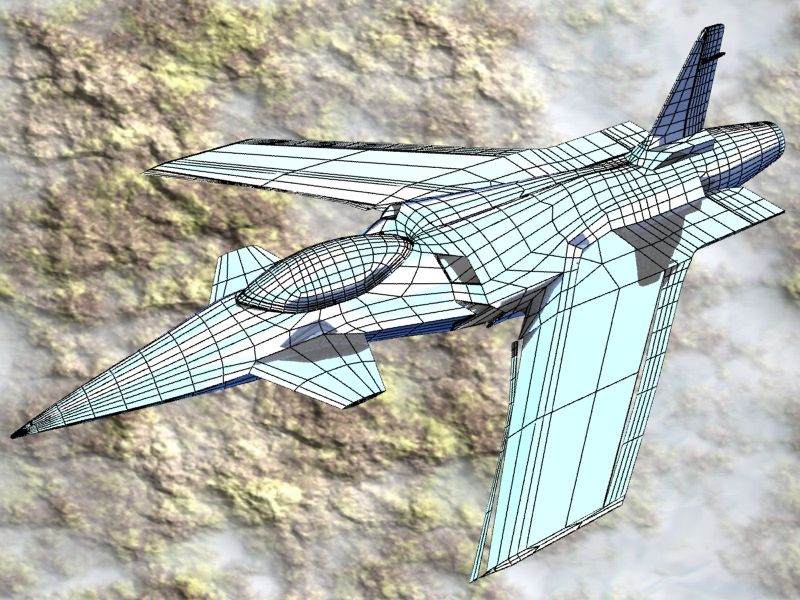The BRAWL² Tournament Challenge has been announced!
It starts May 12, and ends Oct 17. Let's see what you got!
https://polycount.com/discussion/237047/the-brawl²-tournament
It starts May 12, and ends Oct 17. Let's see what you got!
https://polycount.com/discussion/237047/the-brawl²-tournament
Jet Design WIP
I'm designing a model for a jet design. It's a combination of an X-29 jet, and the new F-22, F-35 stealth jets. I wanted a forward wing design due to high maneuverability and lower speeds needed to keep the jets airborne. at the same time wanted to use the stealth smoothed and jagged design to bounce the radar signals off of the hull.
I do need help and critiques on the design and modeling of it so i can improve it all around. please leave any advice you can give to me on how to improve the design of it. all help is welcome



I do need help and critiques on the design and modeling of it so i can improve it all around. please leave any advice you can give to me on how to improve the design of it. all help is welcome



Replies
Aerodynamically, it seems like it's going to be too unstable - the centre of pressure looks like it's going to be way too far forward as soon as it's not going dead straight, especially if you're thinking of it as a fighter in any way (X29 didn't need to worry about fuel loads or weaponry, SU-47 did).
One thing to consider is where you you want the plane to rotate around - this is very important because if you make this point further away from the pilot, it subjects to pilot to higher g forces. Ideally, it's around the cockpit or the canards. This is a result of the general design of planes - if you want the front to point up, twist the rear down. Talking of canards, they usually don't go that far forward, and when they do, they're not that large. Look at the Eurofighter for examples.
I'd also look into boundary layer ingestion - especially the intakes on the top. If the intakes on the side were eating anything other than canard wake I'd be genuinely surprised. The top intakes would probably also starve when then plane isn't flying straight.
For modelling, you've got quite a few floating bits. the control surfaces on the wings, the canards, possibly the engine. You'll also have to look into plugging the gaps when the canards and tailfin/s rotate. A lot of edges seem redundant, like the ones coming from the top intakes, the ones going down the middle of each tail section, and basically all the ones going around the canards. You really don't need a whole lot of edges for stealth wings; only put edges where there isn't a straight line.
Aesthetically, it'd probably work for an RTS game (big features and a decent silhouette), but for a sweet render or third-person game it lacks style and definition.
One thing that helps me is to break out the pen and pencil and see how few lines you can use to get a clean, defined shape. Since you want to go the stealth route, try to make those lines straighter.
The other thing I found helps is to clearly define what you're trying to do. Real plane development programs are ridiculously costly, and therefore each plane is expected to serve multiple purposes and should support several versions (already we're through several F-35 designs). CG stuff doesn't have to be compromised like that, and you can pursue a pure design.
For this design I wanted to more of a rid-range recon jet since the over all model is so small and single engine. Something that could be launched from an overseas base to do intelligence work and go back to base. I will try my hand at a new design after I work out this one as my prototype so to speak for its design.
The help with the aerodynamics helped a lot especially with the SU-47 reference (didn't see it in my research) so I can use that to be incorporated into this design. If what I understand is correct your saying that my cockpit should be pushed up a little from the main body and the area with the intakes pushed back and redesigned a bit so the intakes can suck in air while doing turns. I can pull them off the design and instead put them underneath like the f-22,35 designs and make them larger. I didn't at first due to not understanding how to design the intakes with a stealth design to bounce or redirect radar signals. I'll give it a try and see how it goes.
My edges are a little redundant had a few friends already say that, and i'm working on that issue. Some of those edges are there due to how the wireframe looks when its smoothed. It seems to turn into disarray without some edges and the wireframe gets stretched. If there is a way to get ride of that effect and keep things simple I would love to know it so i can take out my un-needed edges.
It's possible to widen the body significantly, especially around the nose and sides. There's a set of concepts that used strakes as lifting surfaces instead of canards - look into the SR-71 and YF-12. Those large, flat areas on the side of the nose actually produce significant amounts of lift, enough that they don't need canards at all, the only problem being that said lift can't be directly controlled (like canards locked in position).
If you want to push it more into stealth, look into concepts like the B-2, F-117 and most importantly the YF-23. Compared to the F-22, the YF-23 was far more advanced, at least in regards to stealth. Generally the idea is to really go for minimalism; especially in the number of wings and control surfaces.
YF-23
B-2 (note the flaps open on the wing tips? they replace the air brake and the tail fin/s)
F-117 underside
I did some research into forward swept wings and came upon this link to the history of it. http://www.centennialofflight.gov/essay/Evolution_of_Technology/foward_sweep/Tech9.htm
It gave me some incite into how I might design this better along with this image of the YF-23 and how its designed.
http://www.voodoo-world.cz/yf23/pic/yf23load.jpg
I was wondering if canards were needed to be movable like on the X-29 or not. It doesn't seem to be the case rather they are used to be stabilizers mounted in the front rather than on the tail with most aircraft. If that's the only thing they are used for I could adapt the Blackbirds nose design like you said and widen the nose to be used as a canard. I also say that all the stealth jets are very wide and very small in height to reduce their radar signature. all the edges that protrude out seem to go in one uniform line around the aircraft from nose to wings. I guess I need to widen the whole design in order to reduce signature strength, widen the nose to act as canards, put the intakes under the wings and widen them and make the tail more like the F-117's tail wing design. and eliminate the cards and the tail wings as surface areas on it.
I want it to be a high speed manoverable design so i want to keep the fighter jet style.
Alright you gave me a lot to work with yet again thank you very much.
this is the smoothed look of the redesign I like the yf-23's tail design along with he Stealth movie's ship as well. Though in my eyes with the new style its lost the original look of the design that I fell in love with I might go back and try to redo that one by taking out the canards and redoing the intakes while keeping the original structure base.
With these two designs I would like to get any input as to the look. style and also how it would work in real life as an actual design for a jet. I would also like to know peoples thoughts on weather this second design should be the one pushed to a portfolio piece or the original one from my first post should be reworked and improved upon. Please all comments. Thank you
This is an un smoothed view to have people give me any modeling advice needed to improve it.
this is the smoothed design to com pair and get feed back
I'm trying to make this the best I can so for all the posts and pics I apologize but just need help getting the modeling the best I can do it before adding in anything and chopping the design up to make it it a full fledged design for my portfolio.